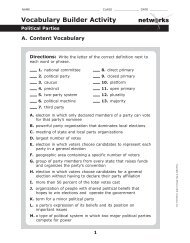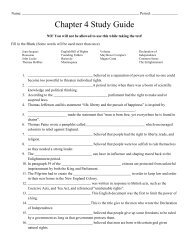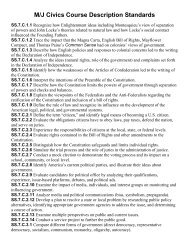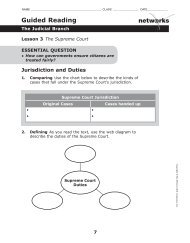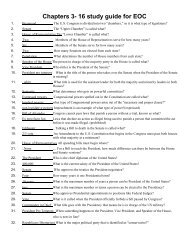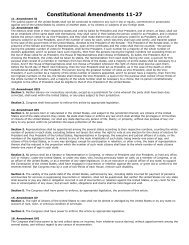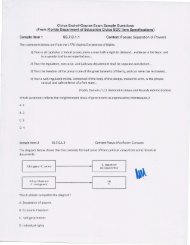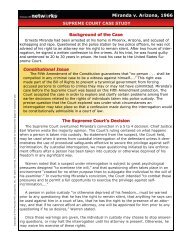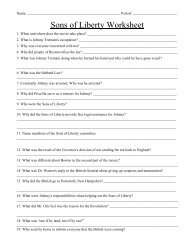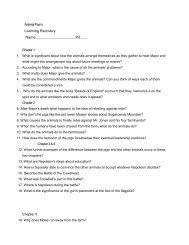Background of the Case The Supreme Court's Decision SUPREME ...
Background of the Case The Supreme Court's Decision SUPREME ...
Background of the Case The Supreme Court's Decision SUPREME ...
Create successful ePaper yourself
Turn your PDF publications into a flip-book with our unique Google optimized e-Paper software.
Brown v. Board <strong>of</strong> Education <strong>of</strong> Topeka, Kansas, 1954<br />
<strong>SUPREME</strong> COURT CASE STUDY<br />
<strong>Background</strong> <strong>of</strong> <strong>the</strong> <strong>Case</strong><br />
Linda Brown, an African American teenager, applied for admission to an all-white<br />
public school in Topeka, Kansas. <strong>The</strong> board <strong>of</strong> education <strong>of</strong> Topeka refused to admit her.<br />
In a 1950 case, Sweatt v. Painter, <strong>the</strong> <strong>Supreme</strong> Court had for <strong>the</strong> first time questioned<br />
<strong>the</strong> constitutionality <strong>of</strong> <strong>the</strong> Plessy decision. <strong>The</strong> Court had held in that case that African<br />
Americans must be admitted to <strong>the</strong> previously segregated University <strong>of</strong> Texas Law<br />
School because no separate but equal facilities existed in Texas. <strong>The</strong> National Association<br />
for <strong>the</strong> Advancement <strong>of</strong> Colored People (NAACP) now saw denying admission to<br />
Linda Brown and o<strong>the</strong>r young African Americans as an opportunity to challenge segregation<br />
in <strong>the</strong> public schools, even though <strong>the</strong> facilities in o<strong>the</strong>r segregated schools for African<br />
Americans were equal to those for white students.<br />
Copyright © <strong>The</strong> McGraw-Hill Companies, Inc. All rights reserved. Permission is granted to reproduce this page for classroom use.<br />
Brown represents a collection <strong>of</strong> four cases, all decided at one time. <strong>The</strong> cases had<br />
one common feature: African American children had been denied admission to segregated,<br />
all-white public schools. <strong>The</strong> cases reached <strong>the</strong> United States <strong>Supreme</strong> Court by<br />
way <strong>of</strong> appeals through lower courts, all <strong>of</strong> which had ruled in accordance with <strong>the</strong> 1896<br />
Plessy decision.<br />
Constitutional Issue<br />
Constitutional Issue<br />
<strong>The</strong> Brown case called for an explicit reappraisal <strong>of</strong> <strong>the</strong> Plessy decision. Did<br />
separate but equal public facilities violate <strong>the</strong> equal protection clause <strong>of</strong> <strong>the</strong><br />
Fourteenth Amendment In <strong>the</strong> case <strong>of</strong> Plessy v. Ferguson, <strong>the</strong> <strong>Supreme</strong> Court had<br />
established <strong>the</strong> separate but equal principle, which allowed <strong>the</strong> continuation <strong>of</strong><br />
segregated schools and public facilities. During <strong>the</strong> 56 years since <strong>the</strong> Plessy decision,<br />
however, Americans’ views on segregation had changed. To many people, <strong>the</strong> very<br />
idea <strong>of</strong> segregated schools as well as o<strong>the</strong>r segregated public facilities seemed to be<br />
out <strong>of</strong> step with <strong>the</strong> times. In <strong>the</strong> years after World War II, <strong>the</strong> NAACP and o<strong>the</strong>r civil<br />
rights groups began pressing for nullification <strong>of</strong> <strong>the</strong> separate but equal idea. <strong>The</strong><br />
justices were not immune to <strong>the</strong> changing social forces in <strong>the</strong> United States. Still, if in<br />
fact <strong>the</strong>y wished to overturn Plessy in <strong>the</strong> Brown case, <strong>the</strong>y faced <strong>the</strong> challenge <strong>of</strong><br />
finding a constitutional basis for <strong>the</strong>ir decision.<br />
<strong>The</strong> <strong>Supreme</strong> Court’s <strong>Decision</strong><br />
<strong>The</strong> Court ruled unanimously to overrule <strong>the</strong> separate but equal principle. Chief Justice<br />
Earl Warren, who wrote <strong>the</strong> decision, was keenly aware that in overruling Plessy, an<br />
act <strong>of</strong> enormous social and political consequences, it was important for <strong>the</strong> entire Court<br />
to be in agreement. <strong>The</strong> Brown ruling was thus issued by a unanimous Court.<br />
In his decision, Warren explained that since <strong>the</strong> relation <strong>of</strong> <strong>the</strong> Fourteenth Amendment<br />
to public schools was difficult to determine, <strong>the</strong> Court would “look instead to <strong>the</strong><br />
effect <strong>of</strong> segregation itself on public education.” <strong>The</strong> chief justice explained, “We must<br />
consider public education in <strong>the</strong> light <strong>of</strong> its full development and its present place in<br />
American life throughout <strong>the</strong> Nation. Only in this way can it be determined if segregation<br />
in public schools deprives <strong>the</strong>se plaintiffs <strong>of</strong> <strong>the</strong> equal protection <strong>of</strong> <strong>the</strong> law.”
Brown v. Board <strong>of</strong> Education <strong>of</strong> Topeka, Kansas, 1954<br />
<strong>SUPREME</strong> COURT CASE STUDY continued<br />
<strong>The</strong> Court concluded that segregation <strong>of</strong> African American schoolchildren “generates<br />
a feeling <strong>of</strong> inferiority as to <strong>the</strong>ir status in <strong>the</strong> community that may affect <strong>the</strong>ir hearts<br />
and minds in a way unlikely ever to be undone.” To bolster his claim about <strong>the</strong> huge<br />
psychological impact <strong>of</strong> segregation, Warren quoted <strong>the</strong> finding <strong>of</strong> a lower court, even<br />
though <strong>the</strong> lower court ruled against <strong>the</strong> African American children. That court had<br />
stated: “Segregation <strong>of</strong> white and colored children in public schools has a detrimental<br />
effect upon <strong>the</strong> colored children. <strong>The</strong> impact is greater when it has <strong>the</strong> sanction <strong>of</strong> <strong>the</strong><br />
law; for <strong>the</strong> policy <strong>of</strong> separating <strong>the</strong> races is usually interpreted as denoting <strong>the</strong> inferiority<br />
<strong>of</strong> <strong>the</strong> Negro group. A sense <strong>of</strong> inferiority affects <strong>the</strong> motivation <strong>of</strong> a child to learn.<br />
Segregation with <strong>the</strong> sanction <strong>of</strong> law, <strong>the</strong>refore, has <strong>the</strong> tendency to [retard] <strong>the</strong> education<br />
and mental development <strong>of</strong> Negro children and to deprive <strong>the</strong>m <strong>of</strong> some <strong>of</strong> <strong>the</strong><br />
benefits <strong>the</strong>y would receive in a racially integrated school system.”<br />
Copyright © <strong>The</strong> McGraw-Hill Companies, Inc. All rights reserved. Permission is granted to reproduce this page for classroom use.<br />
Agreeing with this statement, Warren concluded, “Whatever may have been <strong>the</strong> extent<br />
<strong>of</strong> psychological knowledge at <strong>the</strong> time <strong>of</strong> Plessy v. Ferguson, this finding is amply<br />
supported by modern authority. Any language in Plessy v. Ferguson contrary to this<br />
finding is rejected.”<br />
On this basis <strong>the</strong> Court concluded “that in <strong>the</strong> field <strong>of</strong> public education <strong>the</strong> doctrine <strong>of</strong><br />
‘separate but equal’ has no place. Separate educational facilities are inherently unequal.<br />
<strong>The</strong>refore we hold that <strong>the</strong> plaintiffs and o<strong>the</strong>rs similarly situated for whom <strong>the</strong> actions<br />
have been brought are, by reason <strong>of</strong> <strong>the</strong> segregation complained <strong>of</strong>, deprived <strong>of</strong> <strong>the</strong><br />
equal protection <strong>of</strong> <strong>the</strong> law guaranteed by <strong>the</strong> Fourteenth Amendment. This disposition<br />
makes unnecessary any discussion whe<strong>the</strong>r such segregation also violates <strong>the</strong> due process<br />
clause <strong>of</strong> <strong>the</strong> Fourteenth Amendment.”<br />
In a follow-up to <strong>the</strong> Brown case, in 1955 <strong>the</strong> Court ordered that <strong>the</strong> integration <strong>of</strong><br />
<strong>the</strong> public schools was to go forward “with all deliberate speed.”<br />
DIRECTIONS: Answer <strong>the</strong> following questions on a separate sheet <strong>of</strong> paper.<br />
1. Why do you think <strong>the</strong> Court recognized <strong>the</strong> huge psychological impact that segregated<br />
schools had on children who attended <strong>the</strong>m<br />
2. A constitutional scholar has called <strong>the</strong> Court’s ruling in <strong>the</strong> Brown case “<strong>the</strong> <strong>Supreme</strong><br />
Court’s most important decision <strong>of</strong> <strong>the</strong> twentieth century.” Why do you think he<br />
would make this claim<br />
3. Do you agree or disagree with <strong>the</strong> Court’s ruling in <strong>the</strong> Brown case Give reasons for<br />
your answer.<br />
4. How do you think <strong>the</strong> Court’s Brown ruling was received in <strong>the</strong> South<br />
5. Initially all <strong>the</strong> justices may not have agreed that separate but equal schools were<br />
unconstitutional. Why <strong>the</strong>n do you think <strong>the</strong>y ultimately agreed with <strong>the</strong> chief<br />
justice




